Birds
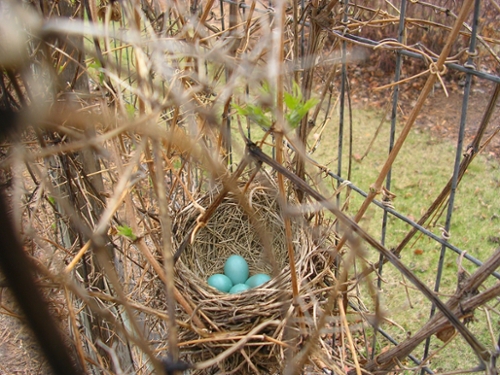
Thanks to Hilda Noton and the Saskatoon Nature Society for keeping an eye and ear out for birds in the Arboretum. Since 2012 the following birds have been recorded (numbers indicate total number of individuals observed from 2012 to present), totaling over fifty species:
-
American Crow (Corvus brachyrhynchos) 63
-
American Goldfinch (Spinus tristis) 9
-
American Redstart (Setophaga ruticilla) 3
-
American Robin (Turdus migratorius) 20
-
Black and White Warbler (Mniotilta varia) 3
-
Black-billed Magpie (Pica hudsonia) 36
-
Black-capped Chickadee (Poecile atricapillus) 73
-
Blackburnian Warbler (Setophaga fusca) 1
-
Blackpoll Warbler (Setophaga striata) 3
-
Blue Jay (Cyanocitta cristata) 6
-
Brown Thrasher (Toxostoma rufum) 3
-
Brown-headed Cowbird (Molothrus ater) 1
-
Canada Warbler (Cardellina canadensis) 2
-
Cedar Waxwing (Bombycilla cedrorum) 16
-
Chestnut-sided Warbler (Setophaga pensylvanica) 2
-
Chipping Sparrow (Spizella passerina) 23
-
Clay-colored Sparrow (Spizella pallida) 11
-
Common Raven (Corvus corax) 3
-
Downy Woodpecker (Picoides pubescens) 1
-
Fox Sparrow (Passerella iliaca) 1
-
Gray Catbird (Dumetella carolinensis) 1
-
Gray Partridge (Perdix perdix) 12
-
Great Horned Owl (Bubo virginianus) 1
-
hawk sp. (Accipitridae sp. (hawk sp.)) 1 either a Swainson's or a Red-tail
-
House Finch (Haemorhous mexicanus) 2
-
House Sparrow (Passer domesticus) 6
-
House Wren (Troglodytes aedon) 11
-
Housefinch (Haemorhous mexicanus) 3
-
Least Flycatcher (Empidonax minimus) 2
-
Lincoln's Sparrow (Melospiza lincolnii) 3
-
Magnolia Warbler (Setophaga magnolia) 2
-
Mallard duck (Anas platyrhynchos) 1
-
Mourning Dove (Zenaida macroura) 1
-
Northern Flicker (Colaptes auratus) 4
-
Orange-crowned Warbler (Oreothlypis celata) 2
-
Palm Warbler (Setophaga palmarum) 2
-
Pine Sisking (Carduelis pinus) 1
-
Red Crossbill (Loxia curvirostra) 8
-
Red-breasted Nuthatch (Sitta canadensis) 6
-
Rock Pigeon (Feral Pigeon) (Columba livia (Feral Pigeon)) 22
-
Rosebreasted Grosbeak (Pheucticus ludovicianus) 2
-
Short-eared owl (Asio flammeus) 1 nearby, not in arboretum
-
Snowy Owl (Bubo scandiacus) 1
-
Song Sparrow (Melospiza melodia) 1
-
Swainson's Hawk (Buteo swainsoni) 2
-
Tennessee Warbler(Oreothylpis peregrina)
-
White-throated Sparrow (Zonotrichia albicollis) 2
-
Wilson's Warbler (Cardellina pusilla) 5
-
Yellow Warbler (Setophaga petechia) 12
-
Yellow-bellied Sapsucker (Sphyrapicus varius) 1
-
Yellow-rumped Warbler (Setophaga coronata) 22
-
American White Pelican (Pelecanus erythrorhynchos) 3
-
Canada Goose (Branta canadensis) 48
-
Franklin's Gull (Leucophaeus pipixcan) 3
-
Great Blue Heron (Ardea herodias) 2
- Turkey vulture (Cathartes aura) several, one sighting
Insects and arachnids
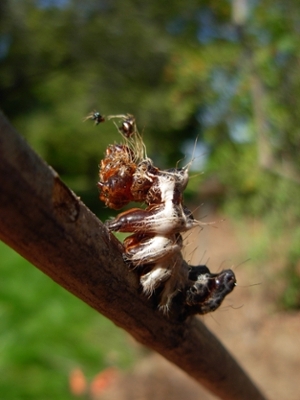
Harris's three-spot caterpillar on a Viburnum
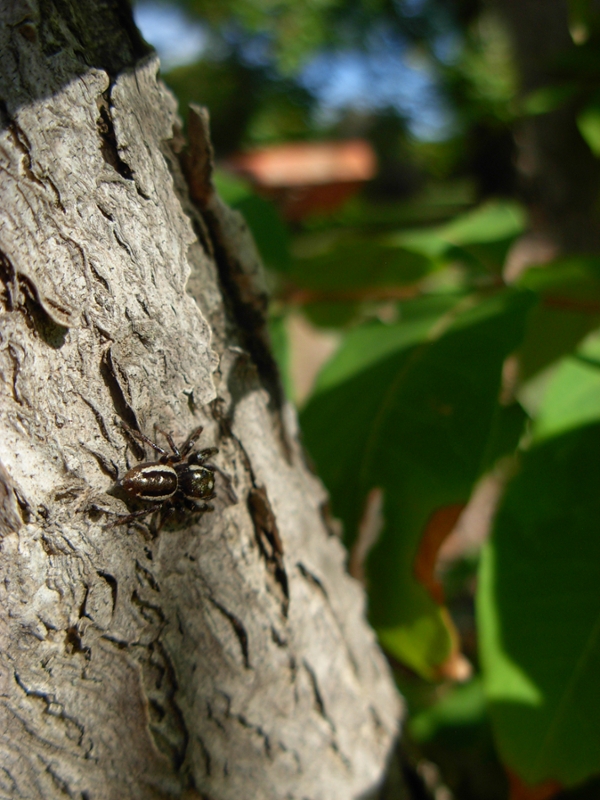
Jumping spider on Sakhalin cork tree (Phellodendron sachalinense). Saskatchewan has approximately 38 species of jumping spider.
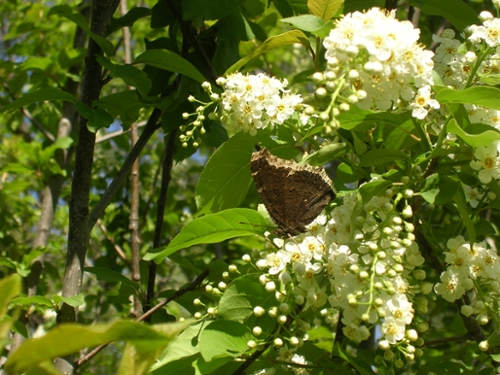
Mourning Cloak butterfly (Nymphalis antiopa) on a Mayday tree (Prunus padus var. commutata).

A bee on flowers of Missouri currant (Ribes odoratum).
Lichens and fungi
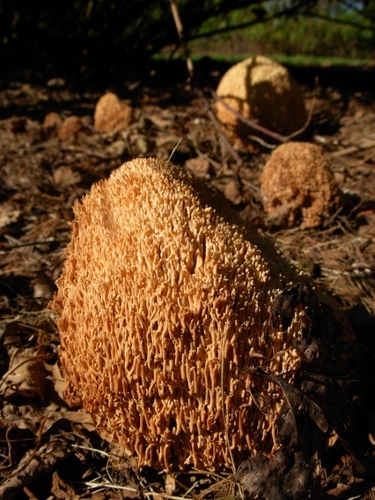
Coral (Clavorioid) fungus appears occasionally.
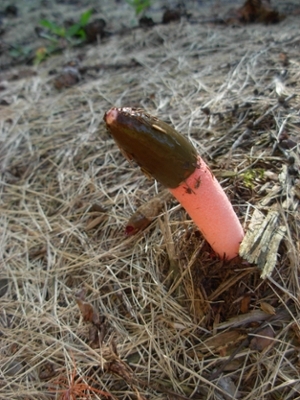
Stinkhorn fungus
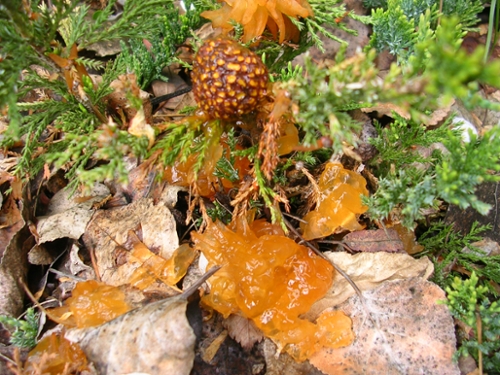
Cedar apple rust fungus (Gymnosporanguim juniperi-virginianae) on a juniper.
Lichens grow in many unlikely places: on bark, soil, rocks, even on tree labels. The diversity of woody plants in the Arboretum provides many habitats and surfaces for these organisms to live. Lichens are unusual in being an organism made up of a fungus and a photosynthetic partner such as a green alga. When growing separately each species will exhibit a different form than when they are growing together.
There are more than 500 lichen species in Saskatchewan, and identifying them to species level can be difficult. Lichens are named by combining the scientific name of the fungus with a common descriptive name such as "starry rosette lichen".
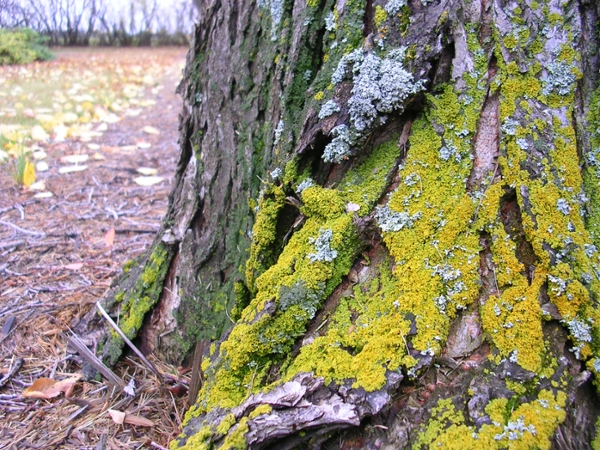
Lichens on an elm tree. Grey lichens are Physcia, probably Physcia stellaris (starry rosette lichen) and Physcia adscendens (rosette lichen); yellow lichens are species of Xanthomendoza.
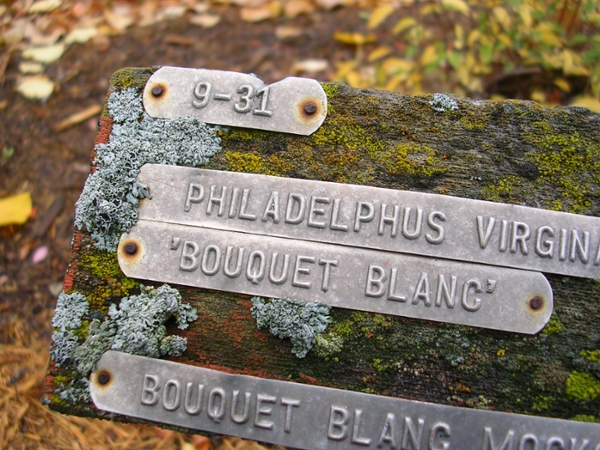
An assortment of crustose (flat) lichen species along with a larger grey species, probably Physcia stellaris (starry rosette lichen).
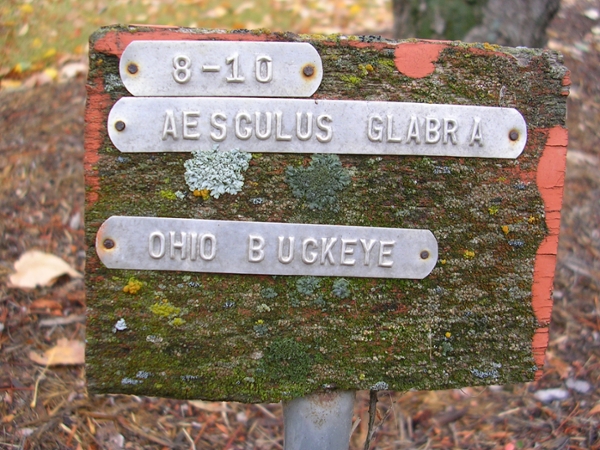
The dark grey-green lichen in the centre of the label may be Phaeophscia orbicularis (mealy shadow lichen). Thanks to Diane Haughland, Lichenologist with the Royal Alberta Museum in Edmonton for helping us to identify these species.
Mammals
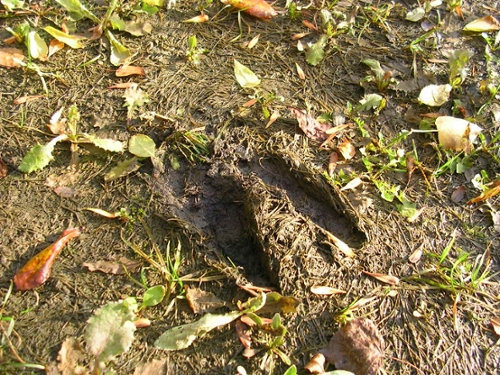
Mammal List
- Meadow vole (Microtus pennsylvanicus) - Resident
- Deer mouse (Peromyscus maniculatus) - Resident
- Least chipmunk (Eutamias minimus) - Occasional
- American red squirrel (Tamiasciurus hudsonicus) - Occasional
- White-tailed jackrabbit (Lepus townsendii) - Common
- Coyote (Canis latrans) - Occasional
- Mule deer (Odocoileus hemionus) - Common
- Moose (Alces alces) - single occurrence

